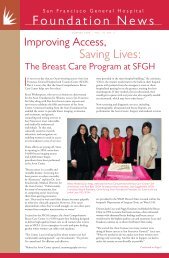Spring (Vol. 11, No. 1) - San Francisco General Hospital Foundation
Spring (Vol. 11, No. 1) - San Francisco General Hospital Foundation
Spring (Vol. 11, No. 1) - San Francisco General Hospital Foundation
You also want an ePaper? Increase the reach of your titles
YUMPU automatically turns print PDFs into web optimized ePapers that Google loves.
As violence came to be viewed as a Public Health<br />
issue, many health care providers struggled with the<br />
challenge of incorporating violence prevention or<br />
intervention into a health care delivery system which was<br />
designed to respond only to the often life threatening injuries<br />
resulting from incidents of violence in the inner-city. “As a<br />
pediatrician practicing adolescent medicine, I found myself<br />
focusing on counseling strategies, trying to guide my patients<br />
away from potentially violent situations when they could be<br />
identified or anticipated,” explains Dr. Pierre-Joseph Marie-<br />
Rose, Pediatrician at the Children’s Health Center, SFGH.<br />
While this type of counseling is a vital component of the<br />
health care professional’s response to violence, many yearned<br />
for a more active form of intervention.<br />
In 1998, having grown increasingly frustrated with the death<br />
and disability resulting from violence in his community, Dr.<br />
Marie-Rose co-founded the Second Chance Tattoo Removal<br />
Program in <strong>San</strong> <strong>Francisco</strong>. The program is a collaboration<br />
between the Central American Resource Center (CARECEN)<br />
and the <strong>San</strong> <strong>Francisco</strong> Department of Public Health. It<br />
provides a chance for a new start and a better future for gang<br />
affiliated youth and young adults, through the removal of<br />
gang related tattoos which pose a threat to their personal safety<br />
S a n F r a n c iis s c o G e n e r a l l H o s p iit t a l l F o u n d a t iio o n N e w s<br />
Breaking the Cycle: Violence Intervention<br />
Through Tattoo Removal comes to SFGH<br />
and can represent an obstacle to securing employment.” It became a way to actively intervene in the violent cycle which gripped my<br />
community,” shares Dr. Marie-Rose, a Potrero Hill native and life-long resident. A significant portion of the trauma cases seen at SFGH,<br />
especially the gunshot wounds and stabbing cases, involve gang affiliated youth.<br />
“For some of these patients, the<br />
fact that they are alive is the true<br />
testimonial,” says Dr. Marie-Rose.<br />
The tattoo removal services are offered at no cost and are coupled with<br />
case management. Lasers are used to target the ink in tattoos. With<br />
each treatment chemical bonds within the ink are broken by the laser,<br />
producing progressively smaller fragments of ink. Once theses fragments<br />
are small enough, the patient’s immune system removes them, and all<br />
evidence of the tattoo disappears. Improvements in technology over the<br />
years have resulted in excellent outcomes. Dr. Marie-Rose has seen first<br />
hand the impact tattoo removal can have on the life of a young person.<br />
“Since I live in the same community where I have provided tattoo removal services for more than a decade, I am often approached by<br />
young adults expressing gratitude for the positive impact the program had on their lives. For some of these patients, the fact that they<br />
are alive is the true testimonial,” says Dr. Marie-Rose. This program is the only one of its kind in <strong>San</strong> <strong>Francisco</strong>, and since its inception,<br />
has treated hundreds patients. While many of the referrals to the program are through word of mouth, case managers coordinate with<br />
community agencies to actively recruit at risk youth, and referrals are received from the Juvenile Justice System as well.<br />
Dr. Marie-Rose, Pediatrician at Children's Health Center, SFGH, uses a laser<br />
to remove a tattoo near a patient's eye.<br />
Pierre-Joseph Marie-Rose, MD, Pediatrician at Children’s Health Center, SFGH<br />
uses laser treatment in what will be one of several sessions to remove an<br />
unwanted tattoo.<br />
<strong>San</strong> <strong>Francisco</strong> <strong>General</strong> <strong>Hospital</strong> <strong>Foundation</strong> awarded a Hearts<br />
Grant to the Second Chance Tattoo Removal Program, which<br />
will allow the program to be brought “back” to SFGH (at<br />
its inception, the Second Chance Tattoo Removal Program<br />
actually started at SFGH before moving away.) “The new<br />
program will incorporate everything we’ve learned over the<br />
last ten years with ‘Second Chance’, and will benefit from the<br />
flexibility of building a program from the ground up,” explains<br />
Dr. Marie-Rose. This will allow an integration of services<br />
with those provided by the SFGH Teen Trauma Recovery<br />
Program’s Wrap-Around Project. The mission of the Wrap-<br />
Around Project is to prevent violent injury and break the cycle<br />
of violence in our most vulnerable communities by addressing<br />
root causes and risk factors with culturally competent case<br />
management and vital community resources. The program<br />
will also work with the UCSF Clinical & Translational<br />
Science Institute in an attempt to design culturally and socially<br />
relevant research projects linked to the program which will<br />
hopefully allow greater insight into the most effective forms of<br />
violence intervention in our community.<br />
7




